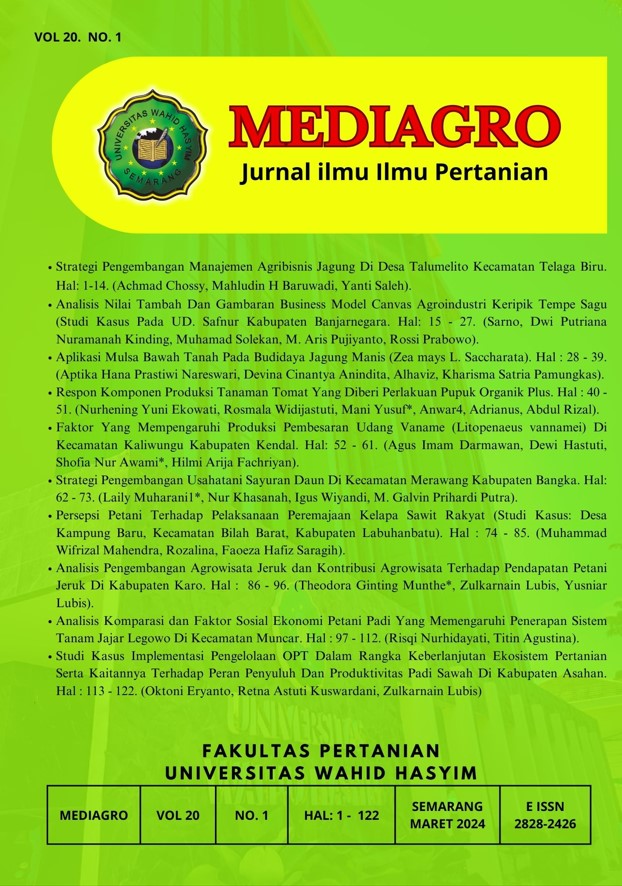Main Article Content
Abstract
Article Details
References
- Ahmed, K. S., Majeed, M. Z., Haidary, A. A., & Haider, N. (2016). Integrated pest management tactics and predatory coccinellids: A review Article in JOURNAL OF ENTOMOLOGY AND ZOOLOGY STUDIES ·. Journal of Entomology and Zoology Studies, 4(1), 591–600.
- Altieri, M. A. (1999). The ecological role of biodiversity in agroecosystems. Agriculture, Ecosystems and Environment, 74(1–3), 19–31. https://doi.org/10.1016/S0167-8809(99)00028-6
- Dainese, M., Martin, E. A., Aizen, M. A., Albrecht, M., Bartomeus, I., Bommarco, R., … Tschumi, M. (2019). A global synthesis reveals biodiversity-mediated benefits for crop production. Science Advances, 5, 1–14.
- Deguine, J. P., Aubertot, J. N., Flor, R. J., Lescourret, F., Wyckhuys, K. A. G., & Ratnadass, A. (2021). Integrated pest management: good intentions, hard realities. A review. Agronomy for Sustainable Development, 41(3). https://doi.org/10.1007/s13593-021-00689-w
- Demestihas, C., Plénet, D., Génard, M., Raynal, C., & Lescourret, F. (2017). Ecosystem services in orchards. A review. Agronomy for Sustainable Development, 37(2). https://doi.org/10.1007/s13593-017-0422-1
- Duru, M., Therond, O., Martin, G., Martin-Clouaire, R., Magne, M. A., Justes, E., … Sarthou, J. P. (2015). How to implement biodiversity-based agriculture to enhance ecosystem services: a review. Agronomy for Sustainable Development, 35(4), 1259–1281. https://doi.org/10.1007/s13593-015-0306-1
- Isbell, F., Adler, P. R., Eisenhauer, N., Fornara, D., Kimmel, K., Kremen, C., … Scherer-Lorenzen, M. (2017). Benefits of increasing plant diversity in sustainable agroecosystems. Journal of Ecology, 105(4), 871–879. https://doi.org/10.1111/1365-2745.12789
- Karp, D. S., Chaplin-Kramer, R., Meehan, T. D., Martin, E. A., DeClerck, F., Grab, H., … Zou, Y. (2018). Crop pests and predators exhibit inconsistent responses to surrounding landscape composition. Proceedings of the National Academy of Sciences of the United States of America, 115(33), 7863–7870. https://doi.org/10.1073/pnas.1800042115
- Kuyper, T. W., & Struik, P. C. (2014). Epilogue: global food security, rhetoric, and the sustainable intensification debate. Current Opinion in Environmental Sustainability, 8, 71–79. https://doi.org/10.1016/j.cosust.2014.09.004
- Ratnadass, A., & Barzman, M. (2014). Ecological Intensifi cation for Crop Protection. Sustainable Agriculture Reviews, 14(October), 185–268. https://doi.org/10.1007/978-3-319-06016-3
- Tscharntke, T., Clough, Y., Wanger, T. C., Jackson, L., Motzke, I., Perfecto, I., … Whitbread, A. (2012). Global food security, biodiversity conservation and the future of agricultural intensification. Biological Conservation, 151(1), 53–59. https://doi.org/10.1016/j.biocon.2012.01.068
- Wezel, A., Bellon, S., Doré, T., Francis, C., Vallod, D., & David, C. (2009). Agroecology as a science, a movement and a practice. Sustainable Agriculture, 2, 27–43. https://doi.org/10.1007/978-94-007-0394-0_3
References
Ahmed, K. S., Majeed, M. Z., Haidary, A. A., & Haider, N. (2016). Integrated pest management tactics and predatory coccinellids: A review Article in JOURNAL OF ENTOMOLOGY AND ZOOLOGY STUDIES ·. Journal of Entomology and Zoology Studies, 4(1), 591–600.
Altieri, M. A. (1999). The ecological role of biodiversity in agroecosystems. Agriculture, Ecosystems and Environment, 74(1–3), 19–31. https://doi.org/10.1016/S0167-8809(99)00028-6
Dainese, M., Martin, E. A., Aizen, M. A., Albrecht, M., Bartomeus, I., Bommarco, R., … Tschumi, M. (2019). A global synthesis reveals biodiversity-mediated benefits for crop production. Science Advances, 5, 1–14.
Deguine, J. P., Aubertot, J. N., Flor, R. J., Lescourret, F., Wyckhuys, K. A. G., & Ratnadass, A. (2021). Integrated pest management: good intentions, hard realities. A review. Agronomy for Sustainable Development, 41(3). https://doi.org/10.1007/s13593-021-00689-w
Demestihas, C., Plénet, D., Génard, M., Raynal, C., & Lescourret, F. (2017). Ecosystem services in orchards. A review. Agronomy for Sustainable Development, 37(2). https://doi.org/10.1007/s13593-017-0422-1
Duru, M., Therond, O., Martin, G., Martin-Clouaire, R., Magne, M. A., Justes, E., … Sarthou, J. P. (2015). How to implement biodiversity-based agriculture to enhance ecosystem services: a review. Agronomy for Sustainable Development, 35(4), 1259–1281. https://doi.org/10.1007/s13593-015-0306-1
Isbell, F., Adler, P. R., Eisenhauer, N., Fornara, D., Kimmel, K., Kremen, C., … Scherer-Lorenzen, M. (2017). Benefits of increasing plant diversity in sustainable agroecosystems. Journal of Ecology, 105(4), 871–879. https://doi.org/10.1111/1365-2745.12789
Karp, D. S., Chaplin-Kramer, R., Meehan, T. D., Martin, E. A., DeClerck, F., Grab, H., … Zou, Y. (2018). Crop pests and predators exhibit inconsistent responses to surrounding landscape composition. Proceedings of the National Academy of Sciences of the United States of America, 115(33), 7863–7870. https://doi.org/10.1073/pnas.1800042115
Kuyper, T. W., & Struik, P. C. (2014). Epilogue: global food security, rhetoric, and the sustainable intensification debate. Current Opinion in Environmental Sustainability, 8, 71–79. https://doi.org/10.1016/j.cosust.2014.09.004
Ratnadass, A., & Barzman, M. (2014). Ecological Intensifi cation for Crop Protection. Sustainable Agriculture Reviews, 14(October), 185–268. https://doi.org/10.1007/978-3-319-06016-3
Tscharntke, T., Clough, Y., Wanger, T. C., Jackson, L., Motzke, I., Perfecto, I., … Whitbread, A. (2012). Global food security, biodiversity conservation and the future of agricultural intensification. Biological Conservation, 151(1), 53–59. https://doi.org/10.1016/j.biocon.2012.01.068
Wezel, A., Bellon, S., Doré, T., Francis, C., Vallod, D., & David, C. (2009). Agroecology as a science, a movement and a practice. Sustainable Agriculture, 2, 27–43. https://doi.org/10.1007/978-94-007-0394-0_3

